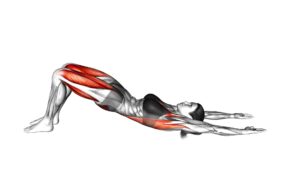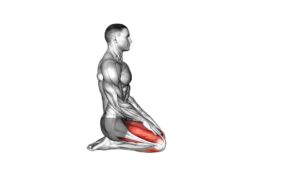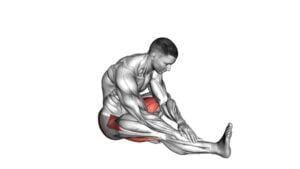Bridge Pose Setu Bandhasana (male) – Video Exercise Guide & Tips

Looking to strengthen your lower back and open up your chest? Bridge pose, also known as Setu Bandhasana, is the perfect exercise for you.
Watch This Exercise Video
In this video exercise guide, we'll walk you through the step-by-step process of performing Bridge pose, along with common mistakes to avoid.
We'll also show you variations and modifications to suit your level of flexibility.
Ready to incorporate Bridge pose into your yoga routine? Let's get started!
Key Takeaways
- Bridge Pose Setu Bandhasana improves flexibility and strengthens back muscles.
- It opens up the chest and shoulders, enhancing posture and breathing.
- The pose relieves tension in the chest, shoulders, and abdomen, promoting relaxation and a sense of calm.
- It brings balance, strength, and flexibility to your practice, offering numerous benefits for overall well-being.
Benefits of Bridge Pose Setu Bandhasana
To understand the benefits of Bridge Pose Setu Bandhasana, you should know that it can help improve flexibility and strengthen your back muscles. Proper alignment is of utmost importance in this pose, as it ensures that you reap the maximum benefits while minimizing the risk of injury. By aligning your shoulders, hips, and knees in a straight line, you create a stable foundation for the pose. This alignment also helps in opening up the chest and shoulders, allowing for better posture and breathing.
Bridge Pose Setu Bandhasana is a great exercise for improving flexibility. As you lift your hips off the ground and arch your back, you stretch the muscles in your chest, shoulders, and abdomen. This stretch not only increases your range of motion but also helps in relieving tension in these areas.
Additionally, the pose strengthens your back muscles, including the erector spinae and the glutes. These muscles play a crucial role in maintaining proper posture and supporting your spine.
Step-By-Step Guide to Perform Bridge Pose Setu Bandhasana
To perform Bridge Pose Setu Bandhasana, you'll need to follow a step-by-step guide that ensures proper alignment and maximizes the benefits of the pose. Here is a guide to help you perform this pose correctly:
- Lie on your back with your knees bent and feet flat on the floor, hip-width apart. Keep your arms by your sides, palms facing down.
- Press your feet into the mat, engaging your glutes and lifting your hips off the ground. Your thighs should be parallel to each other.
- Roll your shoulders underneath you and interlace your fingers, pressing your arms into the mat for support.
- Lengthen your tailbone towards your knees and lift your chest towards your chin. Hold this position for a few breaths, focusing on opening your chest and stretching your spine.
By practicing Bridge Pose Setu Bandhasana regularly, you can experience numerous benefits, such as:
- Strengthening the back muscles and improving posture.
- Stretching the chest, neck, and spine.
- Calming the brain and reducing stress and anxiety.
- Stimulating the abdominal organs and improving digestion.
To deepen your Bridge Pose Setu Bandhasana practice, you can try the following:
- Lift one leg towards the ceiling, extending through the heel.
- Interlace your fingers behind your back and lift your arms off the ground.
- Place a block under your sacrum for a supported variation.
- Practice breathing exercises, such as deep belly breathing, while in the pose to increase relaxation and focus.
Remember to listen to your body and modify the pose as needed. Enjoy the benefits of this rejuvenating pose!
Common Mistakes to Avoid While Practicing Bridge Pose Setu Bandhasana
Avoid these common mistakes while practicing Bridge Pose Setu Bandhasana to ensure proper alignment and maximize the benefits of the pose.
One common mistake is collapsing the chest and shoulders, which can lead to strain in the neck and upper back. To avoid this, focus on lifting the chest towards the chin and lengthening the spine. Keep the shoulders rolled back and down, creating space between the ears and shoulders.
Another mistake is placing the feet too wide apart or too close together. This can affect the stability and balance of the pose. Make sure to position your feet hip-width apart, aligning them parallel to each other.
Additionally, avoid overextending the neck by tucking the chin into the chest. Instead, maintain a neutral position of the neck and gaze towards the ceiling.
Lastly, be mindful of not pushing too hard or forcing the pose beyond your current flexibility level. Remember to listen to your body and only go as far as feels comfortable for you.
By avoiding these common mistakes and practicing with proper alignment, you can safely and effectively perform Bridge Pose Setu Bandhasana.
Now, let's move on to the variations and modifications of this pose.
Variations and Modifications of Bridge Pose Setu Bandhasana
Now let's explore some variations and modifications of Bridge Pose Setu Bandhasana to further enhance your practice and cater to your specific needs. Whether you're a beginner looking for modifications or an advanced practitioner seeking more challenge, these variations will help you customize your practice.
Here are four variations and modifications of Bridge Pose Setu Bandhasana:
- Supported Bridge Pose: If you're a beginner or have limited flexibility, you can place a block or bolster under your sacrum to provide support. This modification allows you to gradually open your chest and hips while maintaining stability.
- One-Legged Bridge Pose: For a more challenging variation, lift one leg off the ground while keeping the other foot firmly planted. This variation engages the core and strengthens the glutes and hamstrings.
- Wheel Pose (Chakrasana): This advanced variation requires more flexibility and strength. From Bridge Pose, place your hands beside your ears and press into the ground to lift your entire body into a full backbend. This deepens the stretch in the chest, shoulders, and hip flexors.
- One-Arm Bridge Pose: For an even more advanced variation, extend one arm overhead while in Bridge Pose. This challenges your balance, strengthens the supporting arm, and opens the chest and shoulders even further.
Tips for Incorporating Bridge Pose Setu Bandhasana Into Your Yoga Routine
To incorporate Bridge Pose Setu Bandhasana into your yoga routine, start by lying on your back with your knees bent and feet flat on the ground. This pose provides various modifications and options to suit different levels of flexibility and strength. If you're a beginner, you can place a yoga block under your sacrum for added support. As you become more comfortable, you can gradually remove the block and lift your hips higher, deepening the stretch in your back and thighs.
Incorporating Bridge Pose Setu Bandhasana into your routine offers numerous benefits. It strengthens the back, glutes, and hamstrings, improves core stability, and stretches the chest, shoulders, and hip flexors. This pose also stimulates the thyroid and boosts energy levels. Additionally, it helps to relieve stress and mild depression, while promoting relaxation and a sense of calm.
However, there are a few precautions to keep in mind. If you have any neck or shoulder injuries, it's important to support your head and neck with a folded blanket or towel. Those with lower back issues should approach this pose with caution and seek guidance from a qualified yoga instructor. Lastly, if you have high blood pressure or any heart conditions, it's best to avoid or modify this pose.
Incorporating Bridge Pose Setu Bandhasana into your yoga routine can bring balance, strength, and flexibility to your practice. Remember to listen to your body, modify as needed, and enjoy the many benefits this pose has to offer.
Frequently Asked Questions
What Are the Different Health Benefits of Practicing Bridge Pose Setu Bandhasana?
Bridge Pose Setu Bandhasana offers various health benefits.
- It strengthens your back, buttocks, and legs, while also stretching your chest, shoulders, and neck.
- This pose can improve your posture and relieve back pain.
- It stimulates your abdominal organs, aiding digestion and metabolism.
- Additionally, it calms your mind and reduces stress.
There are different variations and modifications for beginners to gradually build flexibility and strength.
Incorporating this pose in your routine can enhance your overall well-being.
Are There Any Specific Precautions or Contraindications for Individuals With Certain Medical Conditions While Practicing Bridge Pose Setu Bandhasana?
When practicing Bridge Pose Setu Bandhasana, it's important to be aware of certain precautions and contraindications, especially if you have specific medical conditions.
It's essential to consult with a healthcare professional before attempting this pose if you have any concerns. They can provide guidance based on your individual needs and help ensure that you practice safely.
How Long Should One Hold the Bridge Pose Setu Bandhasana for Maximum Effectiveness?
To maximize the effectiveness of the Bridge Pose Setu Bandhasana, it's important to hold the pose for an appropriate amount of time.
The duration can vary depending on your level of experience and comfort. Beginners may start with holding the pose for 10-15 seconds, gradually increasing the time as they build strength and flexibility.
Advanced practitioners can hold the pose for 30-60 seconds or even longer. Remember to listen to your body and adjust accordingly.
Can Bridge Pose Setu Bandhasana Help in Relieving Lower Back Pain?
Bridge pose, also known as Setu Bandhasana, can be effective in relieving lower back pain. It stretches and strengthens the muscles in your back and helps improve flexibility.
Modified variations of this pose are suitable for beginners who may find it challenging at first. To ensure proper alignment, make sure to press your feet and arms firmly into the ground, lift your hips up towards the ceiling, and engage your core.
Remember to breathe deeply and listen to your body's limits.
Is It Necessary to Warm up Before Attempting Bridge Pose Setu Bandhasana or Can It Be Done as a Standalone Exercise?
It's important to warm up before attempting Bridge Pose Setu Bandhasana. Doing a warm-up routine helps prepare your body for the exercise and reduces the risk of injury. While Bridge Pose can be done as a standalone exercise, warming up beforehand is highly recommended.
This ensures that your muscles are properly stretched and your body is ready for the intensity of the pose. So, make sure to include a warm-up session before attempting Bridge Pose Setu Bandhasana.
Conclusion
In conclusion, Bridge Pose Setu Bandhasana is a beneficial yoga posture that can help improve flexibility, strengthen the core and back muscles, and open up the chest and shoulders.
By following the step-by-step guide and avoiding common mistakes, you can effectively practice this pose. Additionally, incorporating variations and modifications can add variety to your practice.
Remember to listen to your body and make adjustments as needed. Add Bridge Pose Setu Bandhasana to your yoga routine for a well-rounded practice.

Author
Years ago, the spark of my life’s passion ignited in my mind the moment I stepped into the local gym for the first time. The inaugural bead of perspiration, the initial endeavor, the very first surge of endorphins, and a sense of pride that washed over me post-workout marked the beginning of my deep-seated interest in strength sports, fitness, and sports nutrition. This very curiosity blossomed rapidly into a profound fascination, propelling me to earn a Master’s degree in Physical Education from the Academy of Physical Education in Krakow, followed by a Sports Manager diploma from the Jagiellonian University. My journey of growth led me to gain more specialized qualifications, such as being a certified personal trainer with a focus on sports dietetics, a lifeguard, and an instructor for wellness and corrective gymnastics. Theoretical knowledge paired seamlessly with practical experience, reinforcing my belief that the transformation of individuals under my guidance was also a reflection of my personal growth. This belief holds true even today. Each day, I strive to push the boundaries and explore new realms. These realms gently elevate me to greater heights. The unique combination of passion for my field and the continuous quest for growth fuels my drive to break new ground.







